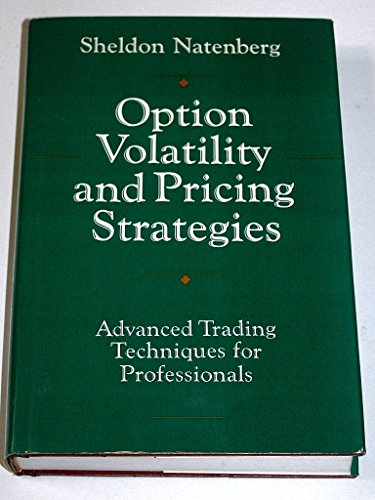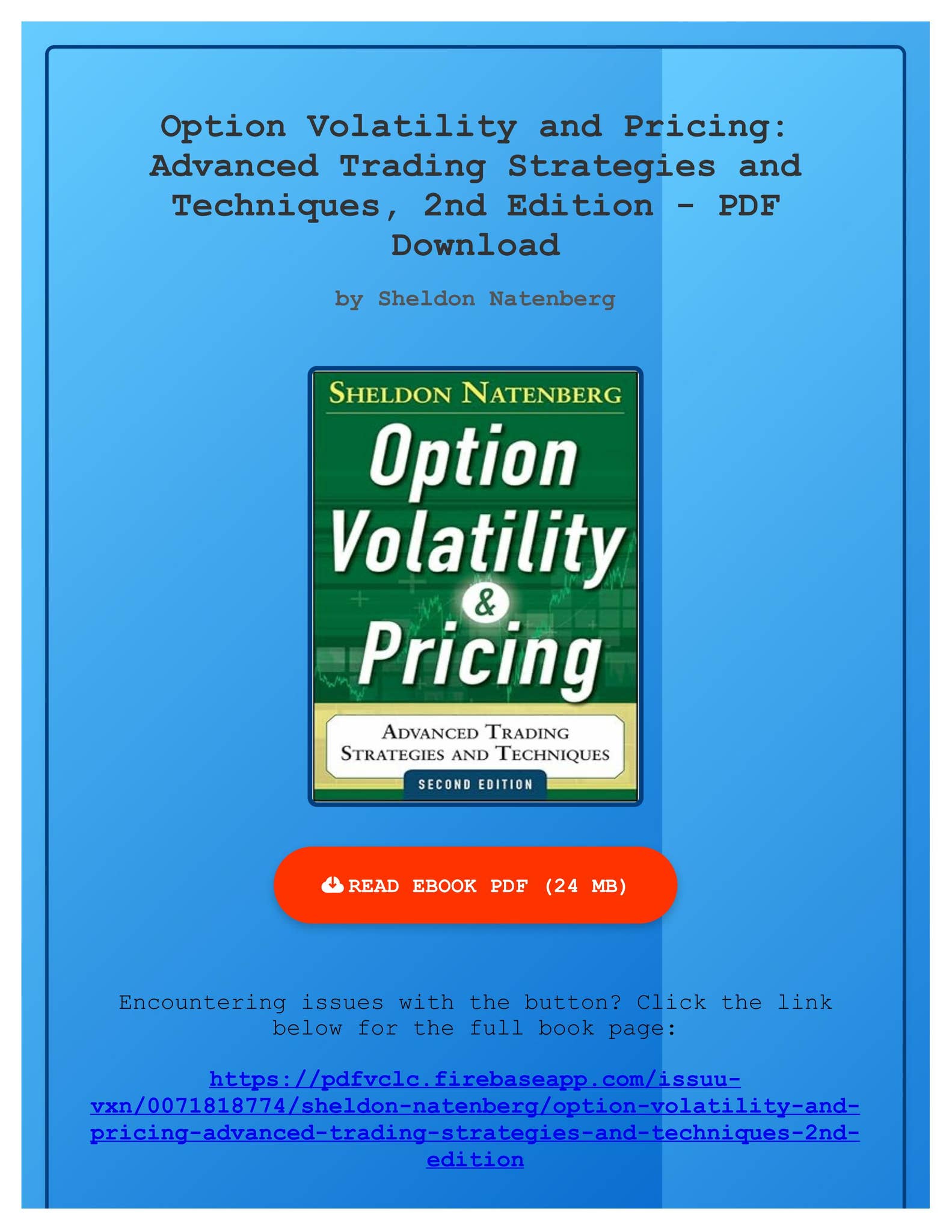Option Volatility & Pricing Advanced Trading Strategies And Techniques

Imagine stepping into a bustling trading floor, the air thick with anticipation. Screens flash charts depicting stock prices, the ebb and flow of numbers mesmerizing and intimidating. Seasoned traders, eyes glued to these symbols, are not merely gambling; they're navigating a complex world of options, volatility, and sophisticated strategies. A world where understanding the subtle dance of market forces can unlock significant profit, and misreading them can lead to catastrophic losses.
This article dives into the intricacies of option volatility and advanced trading strategies, providing insights into how sophisticated traders leverage techniques for pricing and risk management. Understanding these concepts is crucial for anyone aiming to navigate the complexities of modern financial markets, whether you are a seasoned professional or a curious investor.
The Foundations: Understanding Option Volatility
Option volatility, often represented by the VIX (Volatility Index), reflects the market's expectation of future price fluctuations for an underlying asset. It's not just about how much the price might move, but also how quickly. High volatility suggests a wide range of potential price outcomes, while low volatility implies stability. This impacts option prices because options provide the *right*, but not the obligation, to buy or sell an asset at a certain price.
The higher the expected volatility, the more valuable an option becomes. This is because there's a greater chance of the underlying asset's price moving significantly in a favorable direction before the option expires. Conversely, low volatility reduces the probability of a large price swing, decreasing an option's value.
Implied vs. Historical Volatility
Two key types of volatility are relevant to option traders: implied volatility and historical volatility. Implied volatility is derived from the current market price of an option and represents the market's consensus estimate of future volatility. In contrast, historical volatility measures the actual price fluctuations of the underlying asset over a specific past period.
Traders often compare implied and historical volatility to identify potential trading opportunities. For instance, if implied volatility is significantly higher than historical volatility, it may suggest that options are overpriced, potentially presenting a selling opportunity. Conversely, if implied volatility is lower than historical volatility, options might be undervalued.
Advanced Option Trading Strategies
Beyond basic call and put options, sophisticated traders employ a range of advanced strategies to manage risk and generate profits. These strategies often involve combining multiple options with different strike prices and expiration dates to create complex payoff profiles.
Volatility Strategies: Straddles and Strangles
Straddles and strangles are popular volatility-based strategies. A straddle involves buying both a call and a put option on the same asset with the same strike price and expiration date. This strategy profits if the underlying asset's price moves significantly in either direction, regardless of whether it goes up or down.
A strangle is similar to a straddle, but it involves buying a call and a put option with different strike prices. The call option has a strike price above the current market price, and the put option has a strike price below the current market price. This strategy is less expensive than a straddle, but it requires a larger price movement to become profitable.
Delta-Neutral Trading
Delta-neutral trading aims to create a portfolio whose value is insensitive to small changes in the underlying asset's price. Delta measures the sensitivity of an option's price to a change in the price of the underlying asset. By carefully combining options and the underlying asset, traders can construct a portfolio with a delta close to zero.
This strategy is often used by market makers and proprietary trading firms to profit from changes in volatility without taking a directional bet on the underlying asset's price. It requires constant monitoring and adjustments, known as dynamic hedging, to maintain the delta-neutral position.
Iron Condors and Butterflies
Iron condors and butterflies are more complex option strategies designed to profit from limited price movement in the underlying asset. An iron condor involves selling an out-of-the-money call and put option while simultaneously buying further out-of-the-money call and put options to limit potential losses.
A butterfly spread, on the other hand, involves buying and selling options at three different strike prices. It is constructed to profit when the underlying asset's price stays near the middle strike price. Both strategies are highly sensitive to changes in volatility and time decay, requiring careful management.
Pricing Models: The Black-Scholes and Beyond
The Black-Scholes model, developed by Fischer Black and Myron Scholes, is a foundational tool for pricing options. It uses several inputs, including the current price of the underlying asset, the strike price of the option, the time to expiration, the risk-free interest rate, and the implied volatility, to calculate the theoretical value of an option.
While the Black-Scholes model is widely used, it has limitations. It assumes constant volatility, no dividends, and efficient markets. Therefore, more sophisticated models, such as stochastic volatility models and jump-diffusion models, have been developed to address these shortcomings.
The Importance of the Greeks
Understanding the Greeks is crucial for managing option positions. The Greeks are measures of the sensitivity of an option's price to changes in various factors. Key Greeks include Delta (sensitivity to changes in the underlying asset's price), Gamma (sensitivity of delta to changes in the underlying asset's price), Theta (sensitivity to time decay), Vega (sensitivity to changes in volatility), and Rho (sensitivity to changes in interest rates).
Traders use the Greeks to assess the risks associated with their option positions and to adjust their strategies accordingly. For example, a trader who is long volatility might monitor Vega closely and adjust their position if volatility expectations change.
Real-World Applications and Considerations
Option volatility and advanced trading strategies are used in various contexts, from hedging portfolios to speculating on market movements. Institutional investors often use options to protect their portfolios from downside risk, while hedge funds may employ sophisticated volatility strategies to generate alpha.
However, these strategies are not without risks. They require a deep understanding of option pricing, risk management, and market dynamics. Furthermore, transaction costs, slippage, and unexpected market events can significantly impact the profitability of these strategies.
The Future of Option Trading
The landscape of option trading continues to evolve with advancements in technology and changes in market structure. Algorithmic trading, artificial intelligence, and machine learning are playing an increasingly important role in option pricing and execution. The rise of new exchanges and trading platforms is also creating new opportunities for traders.
The future likely holds even more sophisticated trading strategies and risk management tools, requiring traders to continuously adapt and learn. Staying informed about market trends, regulatory changes, and technological advancements is essential for success in the dynamic world of option trading.
As the trading floor quiets down at the end of the day, the data continues to flow, shaping the next day's strategies. The world of option volatility and advanced trading strategies remains a compelling blend of mathematics, psychology, and risk, offering endless possibilities for those who dare to delve into its complexities. It's a constant learning process, a continuous refinement of understanding, but for those who embrace the challenge, the rewards can be substantial.
![Option Volatility & Pricing Advanced Trading Strategies And Techniques [PDF] Download Option Volatility and Pricing Advanced Trading](https://www.yumpu.com/en/image/facebook/65430218.jpg)

















